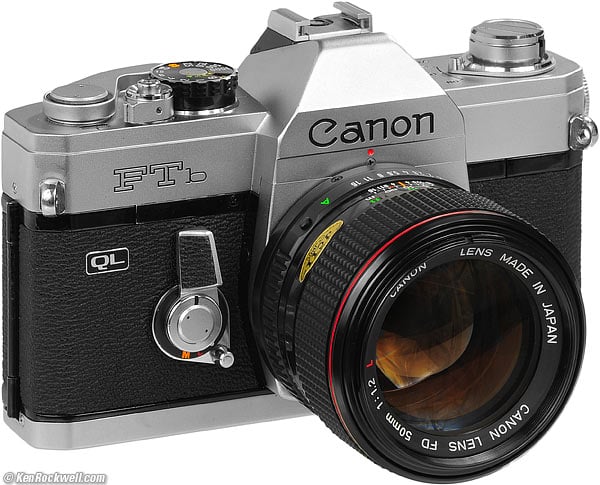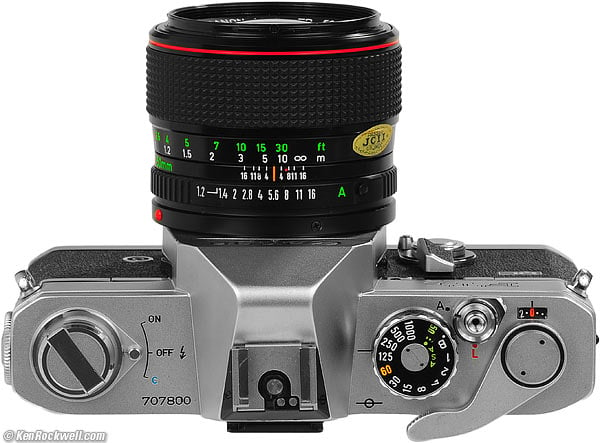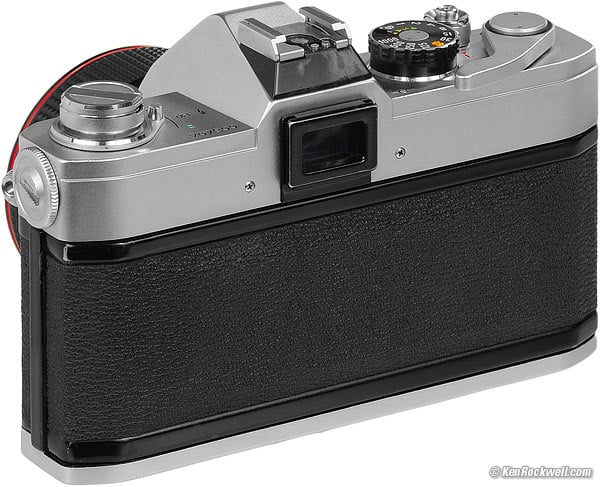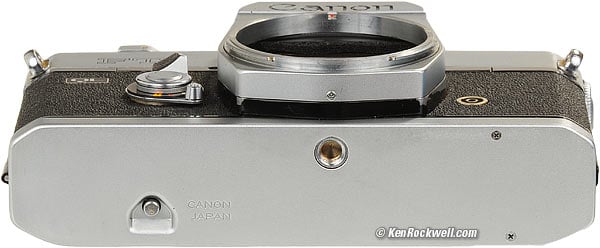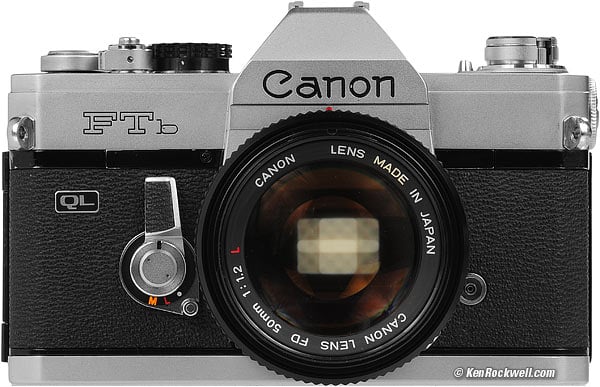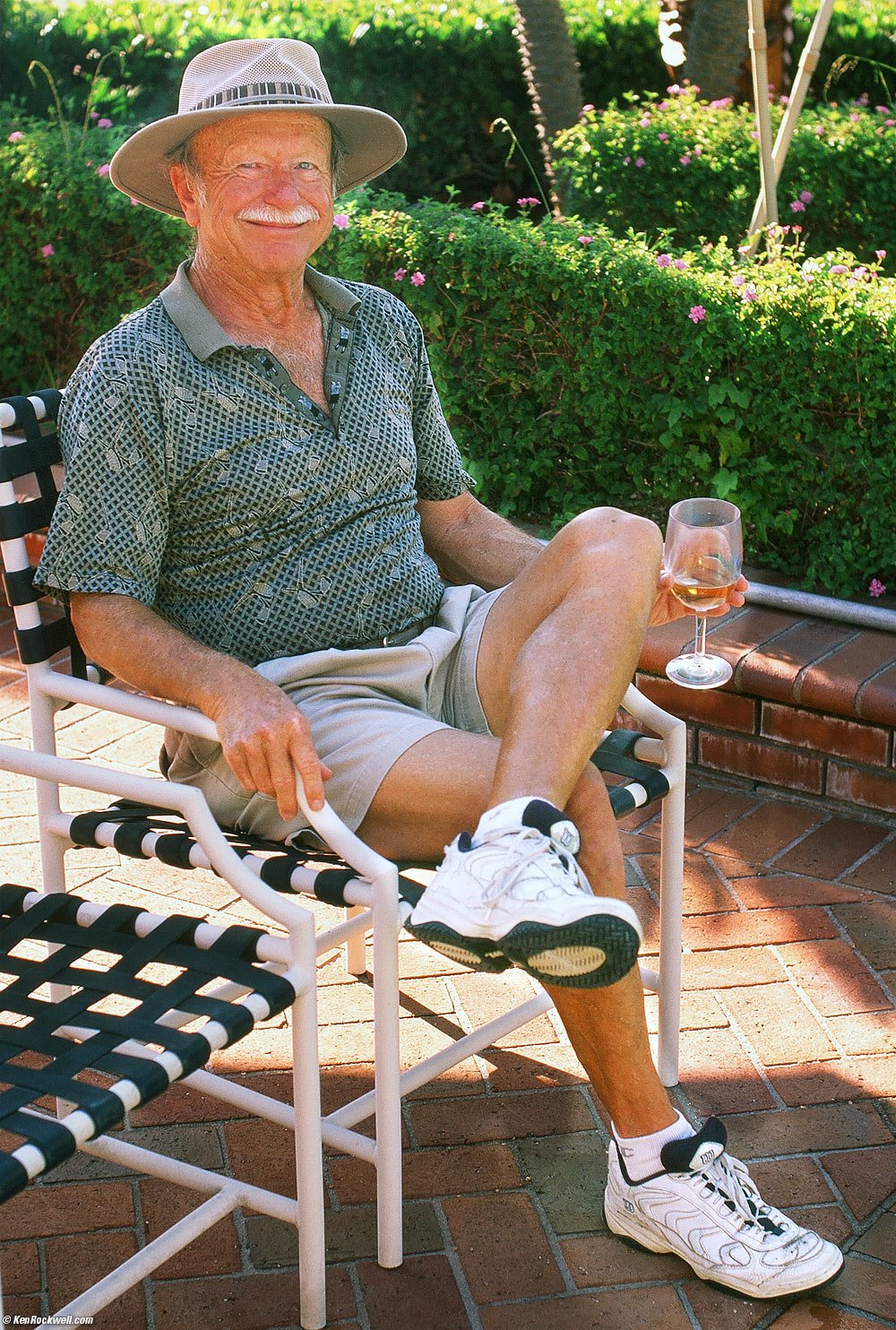Home Donate New Search Gallery Reviews How-To Books Links Workshops About Contact
Canon FTb
FD System QL (Quick-Load, 1971-)
© 2012 KenRockwell.com. All rights reserved.
Intro Specs Performance Compared Usage Recommendations More
Canon FTb (FD , FL and R lenses, 26.870 oz./761.7g wet, about $50 used) and Canon FD 50mm f/1.2 L. enlarge. My biggest source of support is when you use any of these links, especially this link directly to them at eBay (see How to Win at eBay), when you get anything, regardless of the country in which you live. Thanks! Ken.
August 2012 Canon Reviews FD System FD bodies FD Lenses All Reviews
Top, Canon FTb and Canon FD 50mm f/1.2 L. enlarge.
Rear, Canon FTb. enlarge.
Introduction top
Intro Specs Performance Compared Usage Recommendations More
The Canon FTb is a very well thought-out mechanical manual-focus and manual-exposure 35mm SLR.
While originally sold as a consumer SLR, it is more solid and far smoother than most DSLRs of any price today.
The Canon FTb has every feature we need for actual picture taking, and nothing we don't to get in the way.
Specifically superb about the Canon FTb is how the shutter releases without any vibration; a far cry from today's common DSLRs with loads of shutter vibration. In shooting terms, the FTb has a very smooth trigger pull, and far less recoil than anything other than the ultrasmooth New F-1. Canon calls the FTb's mirror system the SMS, the Shockless Mirror System.
When you shoot the FTb, it screams refinement. There is no vibration, which therefore results in sharper pictures.
The FTb has brilliantly simple metering. It reads only from a central rectangular area, with match-needle metering over a very wide range of light. If the range, which actually reads to 2.5 seconds wide-open even at ASA 400 isn't good enough for you, there is a booster available.
The FTb features Quick Loading (QL) which allows one to load film simply by laying it across the film gate and closing the back — no threading required.
The Canon FTb has a big, beautiful 0.85x magnification finder, which is bigger than anything today from Canon. (Canon's 2012 flagship, the $6,800 1D X, has only a 0.76x magnification finder.)
The FTb's shutter has a Time setting: use Bulb, and flick the Lock Collar to L after you press it, and the FTb's shutter will remain open until you release the lock.
Also a class-leader is the FTb's perfectly simple depth-of-field preview lever. Press the big lever at any time, and the lens stops down to taking aperture. Release it and the lens returns to full aperture exactly as it should. No other Canon FD camera has this ability. One of the reasons Canon gave up on the FD mount is that they never again were able to get a depth-of-field preview lever to work as well as it does on this FTb, even on their professional FD cameras.
Likewise, the FTb has an easy-to-use mirror lock-up and and even a lock for the depth-of-field preview lever. I have no idea why Canon was never able to duplicate this on any of its later FD cameras, even the professional ones.
Bottom, Canon FTb. enlarge.
Canon FTb and Canon FD 50mm f/1.2 L. enlarge.
Versions
I'm showing the first 1971 version here.
In 1973 Canon added a plastic tip on the wind lever, and at the end of production, added a finder window to show shutter speed.
In 1971 there were no 50mm f/1.2 L lenses as shown; they didn't come out until 1980. That's no problem; half the reason to shoot an FTb is to use the extraordinary FD L lenses. It's not 1971 anymore.
Specifications top
Intro Specs Performance Compared Usage Recommendations More
Type
Mechanical 35mm SLR.
Manual focus and manual exposure.
TTL match-needle CdS meter.
Full-frame 24 x 36mm image size.
Lens Compatibility
The Canon FTb works with full meter coupling with all traditional breach-lock FD (1971-1979) and New FD (1979-1987) lenses.
With older FL lenses (1964-1971), you'll have to stop-down meter.
R lenses (1959-1964) also mount, but need stop-down metering and manual diaphragm operation.
EOS lenses (1987-today) do not work on the FTb.
Finder
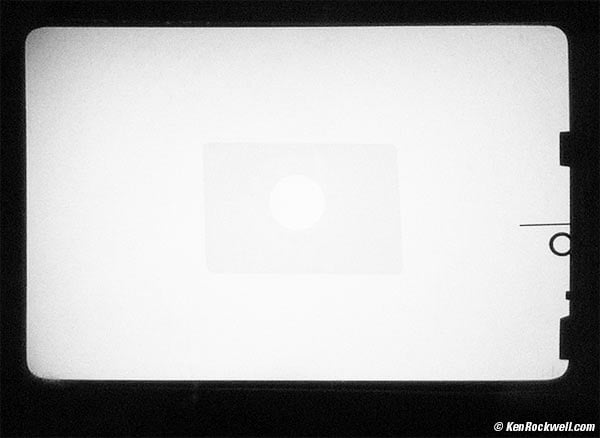
Canon FTb Finder. (the actual finder and metering area is bright and straight; my photo is not.)
Central microprism spot with ground glass and fresnel elsewhere.
Microprism is clear at f/4.7, and starts to go black at f/5.6.
Ground-glass optimized for lenses of f/1.2; unlike new DSLRs, you really can see precise focus and actual depth-of-field with f/1.2 lenses.
Darker central rectangle denotes metering area.
Red flag appear at lower right if camera set out of metering range.
94% coverage.
Huge 0.85x magnification with 50mm lens at infinity.
Takes the same eyecup as the EOS Rebel G and today's other small DSLRs.
Depth-of-field preview and lock.
Mirror lock-up.
Light Meter
TTL match-needle CdS meter.
Reads only central rectangular area (central 12%).
One PX625 or M20 cell.
Battery tester built-in.
ASA 25 ~ 2,000.
Rated for LV 2.5 ~ LV 18 (1/4 second @ f/1.2 to f/16 @ 1/1,000 at ASA 100).
Meter Booster
For ultra-low light there is an optional shoe-mounted meter booster,
Rated down to LV -3.5 ~ LV 10 (15 seconds @ f/1.2 to 1/2 second @ f/22 at ASA 100).
Reads from 30s to 1/30 sec.
Takes two PX625 cells.
2-1/2 x 2-1.8 x 1-1/2 " (65 x 54 x 39mm).
6-3/8 oz. (180g).
Flash
Hot shoe.
(Nikon's first pro camera with a hot shoe didn't come out until seventeen years later in 1988!)
FP and X sync, automatically adjusted.
FP (flashbulbs): 1/1,000 to 1/125, and 1/30 and slower.
X sync: 1/60 and slower.
Flash Exposure
Using the dedicated 103D or 133D speedlites and with an adapter with the appropriate FD 50/1.4, FD 50/1.8 or FD 35/2 lenses, its meter deflects for perfect guide-number exposure based on focused distance! (Canon Auto Tuning (CAT) System.)
Shutter
Horizontal cloth focal-plane.
1 ~ 1/1,000 seconds, Bulb and Time.
Mirror Lock-Up
Self Timer.
Winding
Single 174º stroke, or smaller strokes.
Remote control
Standard screw-in cable release.
Size
Rated 5-5/8 x 3-5/8 x 1-3/4 inches.
Rated 144 x 93 x 43 millimeters.
Weight
26.870 oz. (761.7g), with 36-exposure film and PX625 cell, but no lens or strap lugs.
26.090 oz. (739.6g), with PX625 cell only.
Canon rates it as 23.4 oz. (1.46 lbs or 750g), stripped.
Price
1971: 35,000 yen, Japan list price at introduction, body-only.
1976: $875, adjusted for inflation in 2012 ($220 at the time).
2012: about $50 used.
Optional Accessories
Angle Finder A.
Finder Magnifier.
Finder Dioptric Adjustment lenses.
Performance top
Intro Specs Performance Compared Usage Recommendations More
Pops watching the kids in his pool, 18 August 2012. bigger. (Canon FTb, Canon FD 50mm f/1.2 L, Nikon A2 filter, Fuji Velvia 50, f/4 at 1/60, NCPS process and scan, cropped from larger image.)
Overall
The Canon FTb just goes.
Load, meter, focus and shoot.
Its central-reading meter and vibrationless operation make it a joy to use.
The other great things about the FTb is that it uses Canon's superb and very low-priced FD lenses, especially the FD 14mm f/2.8 L, FD 24mm f/1.4 L, FD 50mm f/1.2 L and FD 85mm f/1.2 L, each of which is smaller and lighter and better built than its EOS equivalent, for half the price with the same calibre optics!
Finder
The finder is big, sharp and simple, as it should be.
It's easy to focus using the huge microprism spot, or snap-focus with fast lenses anywhere in the finder on the ground-glass.
Meter
The meter is plenty accurate for use with professional transparency film like Fuji Velvia 50.
The match-needle meter is much better than the meter in the Minolta SR-T cameras because it reads over a much broader range, and it also reads more precisely.
The FTb does this by auto-ranging the meter needle as ASA and shutter speed change. The meter needle only needs to sweep a range of about 7 stops to cover the lens' apertures. The FTb actually optimizes the meter's sensitivity depending on the shutter setting!
While most match-needle meters attempt to show the entire meter range along their scales, the FTb meter scale only covers the range of apertures of the mounted lens. The meter needle's position auto-ranges as the shutter speed and apertures are set.
The FTb's meter works great at very low light levels since the needle rises as the shutter is set slower. It doesn't crowd the readings together at the low end as many other similar cameras do.
While only rated to read well to a quarter second at ASA 100, mine reads accurately all the way to Bulb (equivalent to 2.5 seconds), even when set to ASA 400!
I have not tried the booster; I don't have one.
Accuracy seems to be unaffected by using an alkaline cell (1.5V or more) in place of the proper mercury or zinc-air cells (1.35V).
Ergonomics
Everything is perfect, especially the vibration-free mirror and depth-of-field preview button and light meter.
My only complaint is that I wish that the meter switch was someplace easier to use with my shooting hand. I'm so cheap with batteries that I try only to turn it on when metering. As-is, it's on the top of the FTb and we move it with our left hands.
The case has no tripod hole or screw; it's held on with two little snaps on each side of the strap lugs. You have to remove the FTb from its case (not shown) to use a tripod.
The shutter dial is non-rotating; it stops at the ends.
Loading and Winding
The QL Quick Load system works great: drop in the film, close the back, and go. (My sample's advance jammed after frame 35; I doubt that this is as designed.)
Long or short wind strokes work swell.
The frame counter is easy to read, with every even number shown from 0 to 38, and dots for odd numbers from -2 to 39. S is at -3.
0, 20 and 36 are in red. (24 isn't special; this was before rolls of 20 grew to 24 exposures.)
Compared top
Intro Specs Performance Compared Usage Recommendations More
Usage top
Intro Specs Performance Compared Usage Recommendations More
Battery
Use any 625 cell, mercury, alkaline or zinc-air.
It screws-in on the side just under the rewind crank.
Battery Check
Set ASA 100 and 1/1,000 (only), set "C" on the meter switch, and read at least to the lower little battery OK tit. Be sure to set this ASA 100 and 1/1,000, otherwise the battery check isn't calibrated.
FD Lens Mounting
The FTb predates automatic exposure FD SLRs; don't try to set A on your lens' aperture ring if you have such a setting; it won't move there.
If you set A on a lens' aperture ring while off the camera, IT WILL NOT MOUNT UNTIL YOU SET IT AWAY FROM A. Canon has deliberately locked this out; don't force anything, just choose any real aperture on your FD lenses before trying to mount them.
Light Meter
Top, Canon FTb and Canon FD 50mm f/1.2 L. enlarge.
The meter switch is the switch marked "ON - OFF - C" around the rewind crank. The "bolt" position is for use with certain flashes, lenses and an adapter to calculate the aperture to use with flash dependant on focused distance and the flash's guide number.
The meter only reads the central darker rectangular area.
Regardless of cell type, my 40-year-old camera is most accurate for my tastes set 1/3 of a stop slower than my film's rating. I set ASA 40 for ASA 50 Velvia. Yours will vary.
The finder shows red on the bottom when the combination of shutter speed and ASA is out of rated meter range. I found my meter was still working fine, even if out of range.
For low light, know that the B setting is equivalent to 2.5 seconds.
Canon says it's OK to use the lens cap to turn off the meter.
I saw no difference in reading between a real mercury EPX625 and an alkaline cell.
Use the Wein cells today if you're concerned.
Shutter Lock
Be sure to set the ring around the shutter button to "A."
The "L" position is a lock against accidental release, or for time exposures.
Time Exposures
Use the Bulb setting, and twist the lever around the shutter button to "L" (Lock) after you've pressed the shutter. It will stay open until unlocked.
Self Timer
Canon FTb and Canon FD 50mm f/1.2 L. enlarge.
Rotate the big lever down and away from the lens.
Press the shutter button to start it.
Depth of Field Preview
Press the big lever toward the lens.
To leave the aperture stopped-down, press and hold the preview lever, and rotate the tiny little lever under the big lever to "L." To release, move the little lever back to the white dot.
Mirror Lock Up
To lock up the mirror, press and hold the big preview lever, and then move the little lever under it to "M."
To release, move the little lever back to the white dot.
If using the self timer at the same time, first charge the self-timer and then lock-up the mirror. To release the mirror after your shot, move the little lever back to the white dot.
Double Exposures
The Canon FTb User's Manual explains how to do this, but asks you to measure 315° rotation on the rewind crank.
Good luck!
Recommendations top
Intro Specs Performance Compared Usage Recommendations More
The Canon FTb is an unusually practical match-needle body for use with all FD, FL and R lenses.
It's shutter is super-smooth and its meter works much better than most other similar cameras of its era.
Especially if you value a real depth-of-field preview, a center-weighted meter, mirror lockup, a finder screen optimized for fast lenses and a vibrationless shutter, the Canon FTb is $50 well spent.
If you've found all the time, effort and expense I put into researching and sharing all this, this free website's biggest source of support is when you use these links, especially this link directly to them at eBay (see How to Win at eBay), when you get anything, regardless of the country in which you live. Thanks! Ken.
More Information top
Intro Specs Performance Compared Usage Recommendations More
Help me help you top
I support my growing family through this website, as crazy as it might seem.
The biggest help is when you use any of these links when you get anything, regardless of the country in which you live. It costs you nothing, and is this site's, and thus my family's, biggest source of support. These places have the best prices and service, which is why I've used them since before this website existed. I recommend them all personally.
If you find this page as helpful as a book you might have had to buy or a workshop you may have had to take, feel free to help me continue helping everyone.
If you've gotten your gear through one of my links or helped otherwise, you're family. It's great people like you who allow me to keep adding to this site full-time. Thanks!
If you haven't helped yet, please do, and consider helping me with a gift of $5.00.
As this page is copyrighted and formally registered, it is unlawful to make copies, especially in the form of printouts for personal use. If you wish to make a printout for personal use, you are granted one-time permission only if you PayPal me $5.00 per printout or part thereof. Thank you!
Thanks for reading!
Mr. & Mrs. Ken Rockwell, Ryan and Katie.
Home Donate New Search Gallery Reviews How-To Books Links Workshops About Contact
